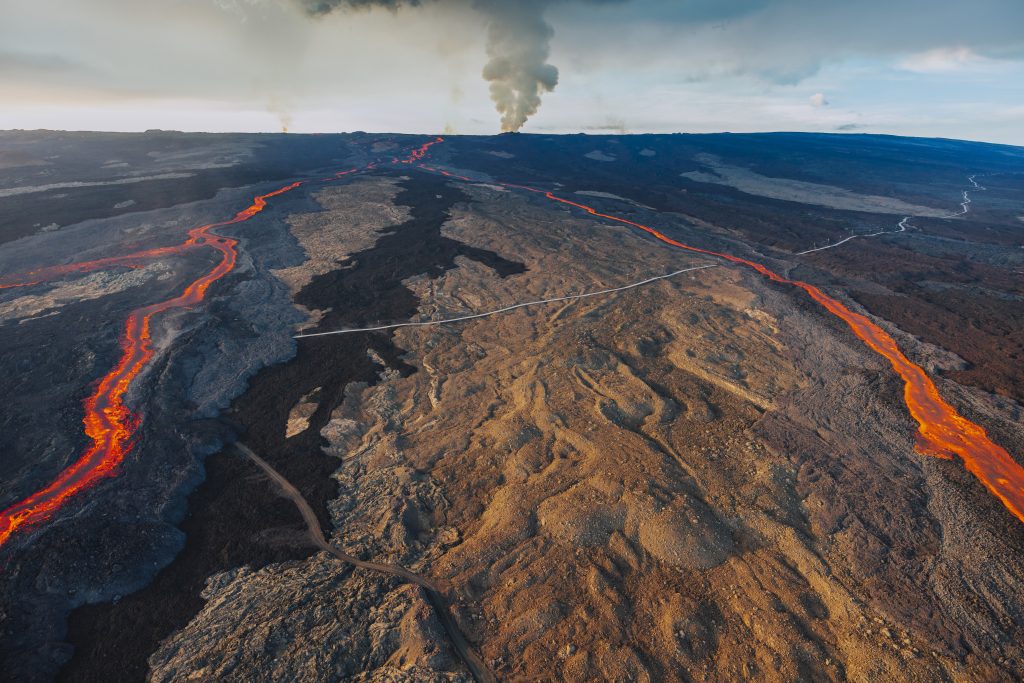The hazards attached to the eruption of Hawaii’s Mauna Loa volcano appear to be mostly under control — promising news for volcanologists, who have been waiting decades for an opportunity to derive data from such a well-observed major eruption without the impediments that come from constant danger.
Mauna Loa is the biggest volcano in the world — measured by area, not destructive capacity — and it’s currently seeing its first eruption since 1984.
“These kinds of events are always super exciting,” said volcanologist Kenneth H. Rubin at the University of Hawaii.
“There are two sides to the general discipline of studying really hazardous natural events,” Rubin said. First and foremost are hazards, and second are the events’ “inherent scientific interest.”
“The Mauna Loa volcano, and Kilauea volcano right next door, are among the best monitored and most frequently erupting volcanoes in the world,” Rubin said. He also noted that The Hawaiian Volcano Observatory is, “the oldest modern volcano observatory on the planet,” and that he and his colleagues have worked hard to “improve the predictability of how eruptions will evolve, if not when they will initiate.”
In other words, they’ve been waiting a long time, and focusing much of their attention on the dangers. But now, all that work may have finally given scientists a chance to focus on the eruption purely as a natural phenomenon, which is a potential boon for everyone’s safety in the long run.
What the Mauna Loa eruption could teach us
As Rubin explained, this is a potential perfect storm of data from satellites, direct observations from the ground, thermal and gas sensors, and — one of Rubin’s own specialties — observations derived from radiation.
As scientists get up close and personal with this lava, they’ll ask things like “Does it have crystals?” according to Rubin, since crystallization of magma helps drive eruptions.
Alternatively “Is it all glass?” Rubin asked, because that would have important impacts on lava viscosity — making it more or less runny, and potentially allowing scientists to more easily calculate dangers.
“How big are the bubbles?” is another question Rubin is asking. Bubble size and density in the magma chamber appears to be a strong determiner of when an eruption will stop.
Prime among the questions Rubin said he’ll be eager to explore is: “Where did this magma come from exactly?”
He explained that Mauna Loa has been seen as ripe for an eruption for years. “We have evidence that magma was injected [relatively recently] and didn’t erupt.”
Learning which magma came from where, and thus, how that not-yet-erupted magma interacts with the fresher magma coming from the mantle, could unlock valuable secrets about the nature of eruptions to come.
As volcanologist and frequent TV talking head Jess Phoenix told the Atlantic on November 29, “This is going to provide us with information on how volcanic eruptions evolve and unfold. And hopefully, we can use this information to help inform public-safety decisions both in Hawaii and around the world.”
Mauna Loa has been erupting for several days as of this writing, with lava emerging from two fissures, which is dribbling lava in a generally northeastern pattern. As of Monday, all that molten rock was gradually creeping toward the Daniel K. Inouye Highway, part of a crucial road system connecting the east and west coasts of the Big Island — but an actual lava-road collision was still about two miles out.
Credit: USGS / public domain
It’s still looking plausible that the lava will make contact with the highway according to a Monday statement from the United States Geological Survey (USGS). However, as of last Thursday afternoon, the flow was slowing down, so road closures won’t come as a surprise, and major interference with life on the Big Island is not looking likely.
Additionally, by Sunday the threat of ash being spewed into the air had dissipated, and the USGS’s aviation warning was downgraded from code “RED” to code “ORANGE.” Pilots, in other words, can be less worried than before about particles from this eruption damaging their engines.
By contrast, during the Kīlauea volcano’s lower Puna eruption in the summer of 2018 — the last Hawaii eruption of comparable magnitude — the volcano repeatedly blasted people with devastating lava bombs and caused $800 million in property damage, including the slow motion destruction of entire tracts of homes.
See the Hawaii volcano eruption from a safe distance
Even if habitations aren’t under threat, curiosity from ever-present sightseers in Hawaii is another hazard at times like this.
USGS, for its part, has been cautious, and duly tweeted warnings. But it has also recommended that Twitter users “get good views all day” from its webcams. According to the Dec. 1 statement from USGS about the eruption, “No property is at risk currently.”
“Some people joke that Hawaii volcanoes are drive-up volcanoes,” Rubin said. But he pointed out that Mauna Loa is at an altitude where the weather is cold, and the lava source isn’t positioned for easy access by vulnerable members of the public.
Also, Mauna Loa’s sheer size, and the gentle slope of the mountain place it at a refreshingly safe distance from most sightseers. Plus, the lava is “relatively runny, and not particularly high in gases.”
“All four of those things work together to make it relatively chill,” Rubin said.
Still, Rubin said, past hazards like “car-sized bombs,” “pyroclastic deposits,” and the threat of toxic gases mean it’s important to be cautious as the eruption takes shape.

